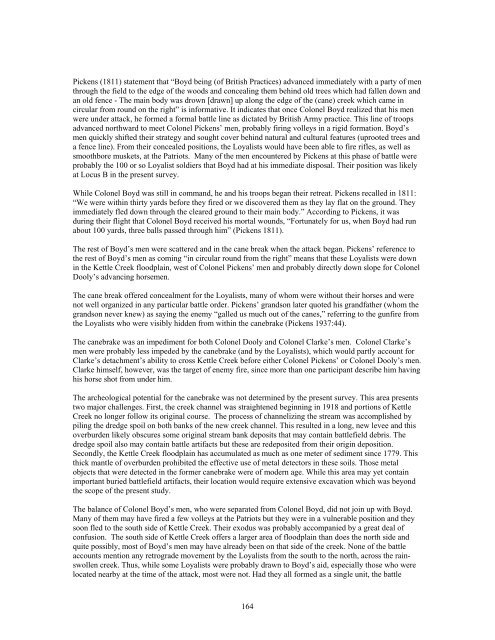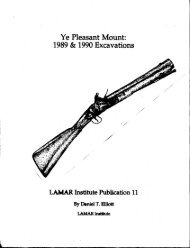Stirring Up a Hornet's Nest: - UGA Laboratory of Archaeology ...
Stirring Up a Hornet's Nest: - UGA Laboratory of Archaeology ...
Stirring Up a Hornet's Nest: - UGA Laboratory of Archaeology ...
You also want an ePaper? Increase the reach of your titles
YUMPU automatically turns print PDFs into web optimized ePapers that Google loves.
Pickens (1811) statement that “Boyd being (<strong>of</strong> British Practices) advanced immediately with a party <strong>of</strong> men<br />
through the field to the edge <strong>of</strong> the woods and concealing them behind old trees which had fallen down and<br />
an old fence - The main body was drown [drawn] up along the edge <strong>of</strong> the (cane) creek which came in<br />
circular from round on the right” is informative. It indicates that once Colonel Boyd realized that his men<br />
were under attack, he formed a formal battle line as dictated by British Army practice. This line <strong>of</strong> troops<br />
advanced northward to meet Colonel Pickens’ men, probably firing volleys in a rigid formation. Boyd’s<br />
men quickly shifted their strategy and sought cover behind natural and cultural features (uprooted trees and<br />
a fence line). From their concealed positions, the Loyalists would have been able to fire rifles, as well as<br />
smoothbore muskets, at the Patriots. Many <strong>of</strong> the men encountered by Pickens at this phase <strong>of</strong> battle were<br />
probably the 100 or so Loyalist soldiers that Boyd had at his immediate disposal. Their position was likely<br />
at Locus B in the present survey.<br />
While Colonel Boyd was still in command, he and his troops began their retreat. Pickens recalled in 1811:<br />
“We were within thirty yards before they fired or we discovered them as they lay flat on the ground. They<br />
immediately fled down through the cleared ground to their main body.” According to Pickens, it was<br />
during their flight that Colonel Boyd received his mortal wounds, “Fortunately for us, when Boyd had run<br />
about 100 yards, three balls passed through him” (Pickens 1811).<br />
The rest <strong>of</strong> Boyd’s men were scattered and in the cane break when the attack began. Pickens’ reference to<br />
the rest <strong>of</strong> Boyd’s men as coming “in circular round from the right” means that these Loyalists were down<br />
in the Kettle Creek floodplain, west <strong>of</strong> Colonel Pickens’ men and probably directly down slope for Colonel<br />
Dooly’s advancing horsemen.<br />
The cane break <strong>of</strong>fered concealment for the Loyalists, many <strong>of</strong> whom were without their horses and were<br />
not well organized in any particular battle order. Pickens’ grandson later quoted his grandfather (whom the<br />
grandson never knew) as saying the enemy “galled us much out <strong>of</strong> the canes,” referring to the gunfire from<br />
the Loyalists who were visibly hidden from within the canebrake (Pickens 1937:44).<br />
The canebrake was an impediment for both Colonel Dooly and Colonel Clarke’s men. Colonel Clarke’s<br />
men were probably less impeded by the canebrake (and by the Loyalists), which would partly account for<br />
Clarke’s detachment’s ability to cross Kettle Creek before either Colonel Pickens’ or Colonel Dooly’s men.<br />
Clarke himself, however, was the target <strong>of</strong> enemy fire, since more than one participant describe him having<br />
his horse shot from under him.<br />
The archeological potential for the canebrake was not determined by the present survey. This area presents<br />
two major challenges. First, the creek channel was straightened beginning in 1918 and portions <strong>of</strong> Kettle<br />
Creek no longer follow its original course. The process <strong>of</strong> channelizing the stream was accomplished by<br />
piling the dredge spoil on both banks <strong>of</strong> the new creek channel. This resulted in a long, new levee and this<br />
overburden likely obscures some original stream bank deposits that may contain battlefield debris. The<br />
dredge spoil also may contain battle artifacts but these are redeposited from their origin deposition.<br />
Secondly, the Kettle Creek floodplain has accumulated as much as one meter <strong>of</strong> sediment since 1779. This<br />
thick mantle <strong>of</strong> overburden prohibited the effective use <strong>of</strong> metal detectors in these soils. Those metal<br />
objects that were detected in the former canebrake were <strong>of</strong> modern age. While this area may yet contain<br />
important buried battlefield artifacts, their location would require extensive excavation which was beyond<br />
the scope <strong>of</strong> the present study.<br />
The balance <strong>of</strong> Colonel Boyd’s men, who were separated from Colonel Boyd, did not join up with Boyd.<br />
Many <strong>of</strong> them may have fired a few volleys at the Patriots but they were in a vulnerable position and they<br />
soon fled to the south side <strong>of</strong> Kettle Creek. Their exodus was probably accompanied by a great deal <strong>of</strong><br />
confusion. The south side <strong>of</strong> Kettle Creek <strong>of</strong>fers a larger area <strong>of</strong> floodplain than does the north side and<br />
quite possibly, most <strong>of</strong> Boyd’s men may have already been on that side <strong>of</strong> the creek. None <strong>of</strong> the battle<br />
accounts mention any retrograde movement by the Loyalists from the south to the north, across the rainswollen<br />
creek. Thus, while some Loyalists were probably drawn to Boyd’s aid, especially those who were<br />
located nearby at the time <strong>of</strong> the attack, most were not. Had they all formed as a single unit, the battle<br />
164










